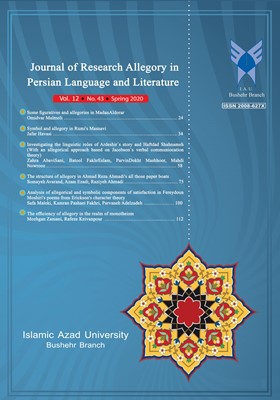Investigating the linguistic roles of Ardeshir`s story and Haftdad Shahnameh (With an allegorical approach based on Jacobson`s verbal communiocation theory)
Subject Areas : Research Allegory in Persian Language and LiteratureZahra AbaviSani 1 , Batool FakhrEslam 2 * , ParvinDokht Mashhoor 3 , mahdi novrooz 4
1 - PhD student in Persian Language and Literature, Islamic Azad University, Neyshabour Branch, Neyshabour, Iran
2 - Assistant Professor, Department of Persian Language and Literature, Islamic Azad University, Neyshabour Branch, Neyshabour, Iran
3 - Assistant Professor, Department of Persian Language and Literature, Islamic Azad University, Neyshabour Branch, Neyshabour, Iran
4 - Assistant Professor, Department of Persian Language and Literature, Islamic Azad University, Neyshabour Branch, Neyshabour, Iran
Keywords:
Abstract :
Language is a set of signs, causes, and effects that make a particular cohesion, the foundation of literary creation, and the provider of new thoughts. Ferdowsi speaks of myth and mystery in some of Shahnameh`s stories, such as Ardeshir`s story and Karam Haftdad, which is presented in allegorical and different way. In addition to analyzing linguistic roles and communication model, this study examines the hidden codes and symbols in the story.Because of the coded allegories in the story, the main role of meta- language is that the main purpose of this study to understand and receive abstract messages and identify important secondary historical, social, and political meanings that have been codified. Understanding the new category of allegorical and symbolic works at the height of the epic and the kind of teaching that is also reported in historical stories.Finally, we find that Jacobson`s linguistic roles are appropriate for understanding the effect of coding, persuasion, and referral messages.
_||_

